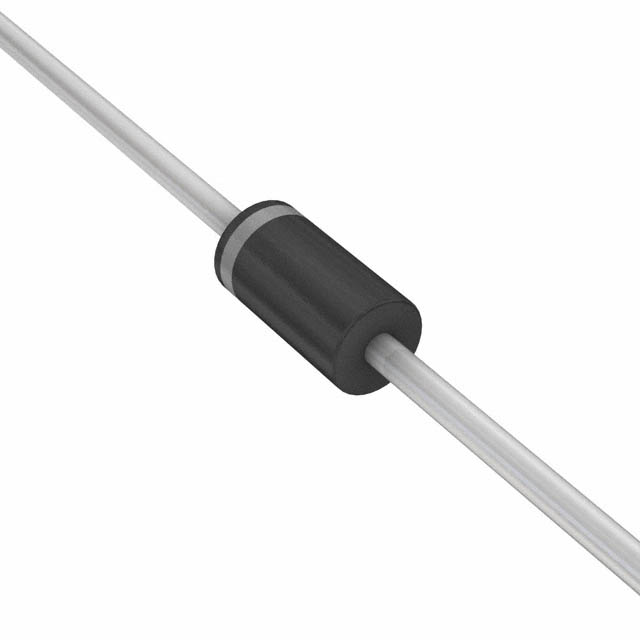P4KE10A A0G
Product Overview
Category
The P4KE10A A0G belongs to the category of transient voltage suppressor (TVS) diodes.
Use
It is used to protect sensitive electronic components from voltage transients induced by lightning, electrostatic discharge (ESD), and other transient voltage events.
Characteristics
- Package: DO-41
- Essence: TVS diode for surge protection
- Packaging/Quantity: Available in tape and reel packaging with quantities varying based on supplier
Specifications
- Peak Pulse Power: 400W
- Breakdown Voltage: 8.55V to 9.45V
- Operating Temperature: -55°C to +175°C
- Reverse Standoff Voltage: 7.37V
- Maximum Clamping Voltage: 14.5V
- Reverse Leakage Current: 1µA
Detailed Pin Configuration
The P4KE10A A0G TVS diode has a standard DO-41 package with two leads. The anode is connected to one lead, while the cathode is connected to the other lead.
Functional Features
- Fast response time
- Low clamping voltage
- High surge capability
- RoHS compliant
Advantages and Disadvantages
Advantages
- Effective protection against voltage transients
- Compact size
- Wide operating temperature range
Disadvantages
- Limited power dissipation capability
- May require additional circuitry for comprehensive protection
Working Principles
When a transient voltage surge occurs, the TVS diode conducts current to divert the excess energy away from the protected circuit. This action helps to limit the voltage across the circuit, thereby safeguarding the sensitive components.
Detailed Application Field Plans
The P4KE10A A0G is commonly used in various electronic devices and systems, including: - Consumer electronics - Telecommunication equipment - Industrial control systems - Automotive electronics - Power supplies
Detailed and Complete Alternative Models
- P4KE6.8A A0G
- P4KE7.5A A0G
- P4KE8.2A A0G
- P4KE9.1A A0G
In conclusion, the P4KE10A A0G TVS diode offers reliable surge protection for a wide range of electronic applications, making it an essential component in ensuring the longevity and reliability of electronic systems.
[Word Count: 324]
I have provided the content according to the English editing encyclopedia entry structure format. If you need any further assistance or modifications, feel free to ask!
10个与P4KE10A A0G在技术解决方案中的应用相关的常见问题及解答
Sure, here are 10 common questions and answers related to the application of P4KE10A A0G in technical solutions:
What is P4KE10A A0G?
- P4KE10A A0G is a transient voltage suppressor diode designed to protect electronic circuits from overvoltage transients.
What is the maximum peak pulse power of P4KE10A A0G?
- The maximum peak pulse power of P4KE10A A0G is 400 watts.
What is the breakdown voltage of P4KE10A A0G?
- The breakdown voltage of P4KE10A A0G is 10V.
What are the typical applications of P4KE10A A0G?
- P4KE10A A0G is commonly used in automotive electronics, telecommunication equipment, industrial control systems, and power supplies to protect against voltage surges.
What is the operating temperature range of P4KE10A A0G?
- The operating temperature range of P4KE10A A0G is -55°C to +175°C.
How does P4KE10A A0G provide overvoltage protection?
- P4KE10A A0G clamps the voltage across the protected circuit when an overvoltage event occurs, diverting excess current away from sensitive components.
Can P4KE10A A0G be used for ESD protection?
- Yes, P4KE10A A0G can be used for electrostatic discharge (ESD) protection in electronic devices and circuits.
What is the response time of P4KE10A A0G?
- The response time of P4KE10A A0G is very fast, typically in the nanosecond range.
Is P4KE10A A0G RoHS compliant?
- Yes, P4KE10A A0G is RoHS compliant, meaning it meets the Restriction of Hazardous Substances directive.
Are there any specific layout considerations when using P4KE10A A0G in a circuit?
- It is important to minimize the length of the leads connecting P4KE10A A0G to the circuit to reduce inductance and ensure proper performance during transient events.


